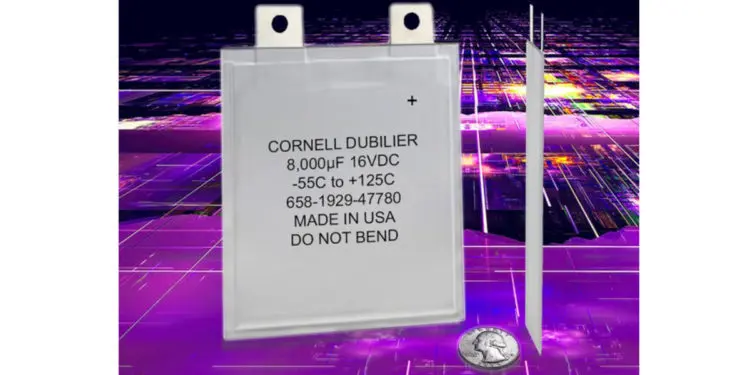The new PPC Series of ultra-thin polymer aluminum electrolytic capacitors from Cornell Dubilier represents a totally new capacitor form factor. Designed specifically for applications requiring high ripple current and the thinnest possible profiles, type PPC opens up new product design options.
In addition to being just 1 mm thin, the PP uses versatile packaging technology that makes it possible for capacitors to be formed into custom shapes and sizes to accommodate available space.
“A single PPC capacitor offers capacitance and ripple current equivalent to dozens of SMT capacitors or a bulky cylindrical device,” said Mario DiPietro, Product Manager at Cornell Dubilier. As an example, the company claims that a single PPC capacitor is equivalent to a parallel bank of 50 or more polymer tantalum capacitors and occupies one fourth the height. Also, circuit reliability is improved by using a single component versus an entire array of SMT capacitors.
Custom values are available within a capacitance range of 8,000µF to 20,000µF, with working voltages ranging from 6.3 to 24 WVDC. The company plans to extend the series to higher operating voltages later in the year. Operating life is 2,000 hours @ 125° C.
The PPC is rated for 10g peak for vibration and withstands shocks up to 100 g’s (MIL-STD-202, Method 213, Condition I). With flat tin-plated copper terminations, it is possible to mount the device off-board or directly to a PCB. Mounting is by means of 3M double-sided VHB tapeTM, to ensure that the entire capacitor surface is kept rigid.
Developed by Cornell Dubilier, the PPC is the latest leading-edge capacitor development by the company. These designs have been responsive to market demands for capacitors that provide higher performance while breaking away from traditional cylindrical form factors.
Highlights
- +125 °C, Up to 2,000 Hours Load Life
- Low Leakage Current
- Very Low ESR and High Ripple Current
- Just 1mm thin
































